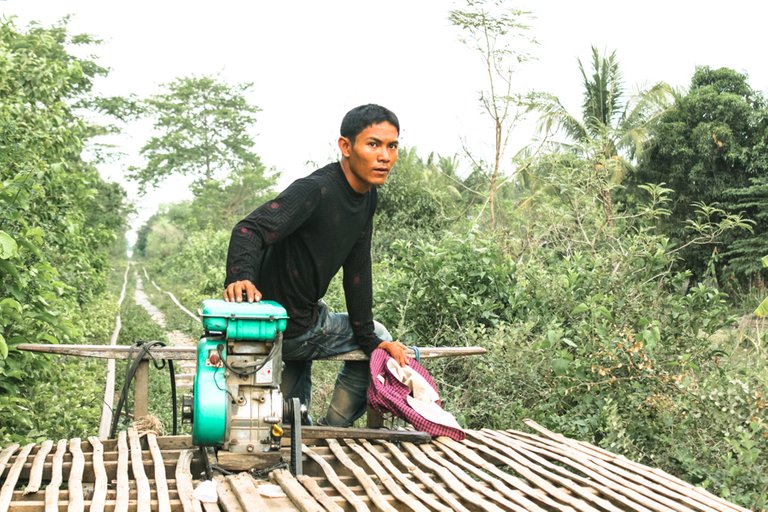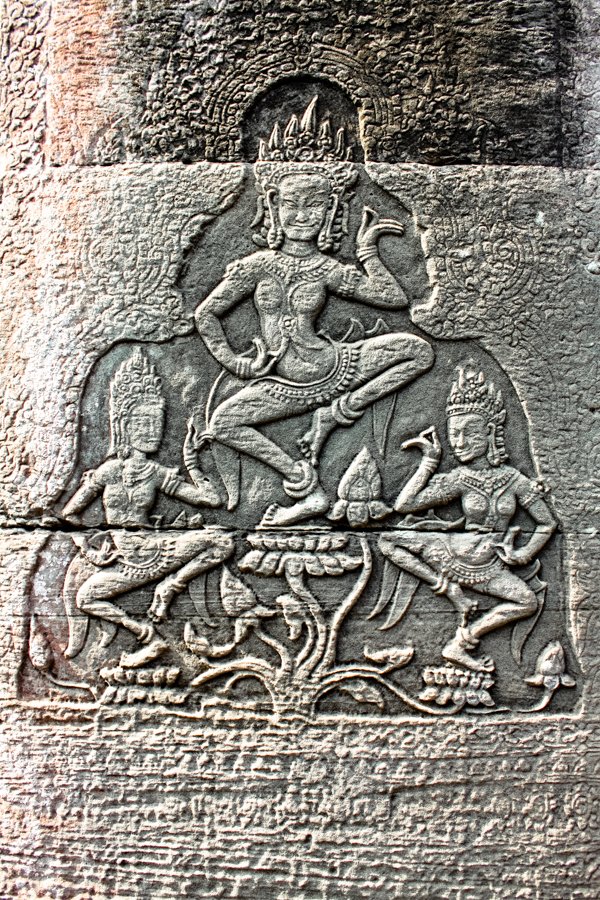Just off the banks of the Tonle Sap River, near a cluster of guest houses, budget hotels, and restaurants, you’ll catch Khmer children competing to sell tourists photocopied books. Always ready to greet, gab, hustle, and haggle, practice and necessity have made them the supremely savvy. Each adopts nuanced (often fluid) sales techniques. Some stare meekly behind their paperbacks, watery, tracking eyes pleading for success. Others approach confidently, “Hey, you, where you from?” they ask, serving up curious conversation or smart alecky charm before brandishing their pitches, pleas, and prescriptions. They know you’re probably just stopping over here, in Phnom Penh, before heading east across the muddy Mekong delta, to Vietnam, or westward, to explore their ancient stone city on your way to trek through Thailand, or laze about in luscious Laos. Lucky for our seasoned sales-boys and girls, all paths involve long bus or boat rides. For the former, they recommend North Vietnamese soldier Bao Ninh’s semi-autobiographical, appropriately-titled The Sorrow of War. For westbound wanderers, making a first stop in their kingdom’s current capital, it’s almost always Loung Ung’s survivor account, First They Killed My Father.

Inside, you’ll peer into the heart-wrenching horror of the 1975-1979 Cambodian genocide, through the eyes of young Loung and her family. Yale University estimates the loss of 1.7 million people; a 21% mortality rate among an approximate population of 8 million, but casualty estimate reports range from 740,000 and 3 million, nearly half the country. Their Cambodian Genocide Program’s introductory literature brings immediate perspective via comparisons to the Armenian genocide, Jewish Holocaust, and more recent devastations in East Timor, Guatemala, Yugoslavia, and Rwanda. “The Khmer Rouge regime headed by Pol Pot combined extremist ideology with ethnic animosity and a diabolical disregard for human life to produce repression, misery, and murder on a massive scale” (http://www.yale.edu/cgp), it summarily states. Unfortunately, like so many of its Southeast Asian neighbors, Cambodia’s history and fortunes are often glanced over or ignored by once-formally imperialist Western powers, whose abuses, post-colonial interferences, and influences played a major role in setting the stage for such tragedy.
Crammed between Thailand to the west and north, Vietnam to the east and southeast, and Laos to the northeast, Cambodia serves as a Southeast Asian crossroads of sorts. Proportionally, Khmer people dominate the country. Their culture, obviously unique in its own right, represents a rather abrupt westerly transition from Chinese to Indian subcontinental influence in the region. Today, the vast majority (95%, according to the U.S. state department) of the nation’s current 13.5 million residents claim to practice Theravada Buddhism, a “conservative” school said to mirror early strains imported from India. So much more than a satellite emulator, Cambodia features a rich ancient history, famously brought to life every splendid sunrise over Angkor Wat, an awe-inspiring “ruined” stone capital aging gracefully outside the blossoming city of Siem Reap. Here, we wish to focus on its relatively modern trials, those familiar to Loung, and the next-generation street kids who hawk her oft-pirated publication.

Throughout the latter half of the 19th century, Cambodia transitioned from (an admittedly troubled) sovereign state, to French protectorate, to virtual colony. France first dreamt of making Cambodia a trader’s paradise, the so-called “Singapore of Indochina” (http://www.ess.uwe.ac.uk/genocide/cambhist1.htm). When it failed to develop into such a hub, disappointed imperialist overlords decided nonetheless to continue to “safeguard” their possession by systematically snatching all true power from the Khmer god-kings they kept as convenient figureheads, and placing it in loyal French bureaucratic hands. Before corn and rubber booms of the 1920s, the French introduced relatively little infrastructure, content to collect the highest taxes in Indochina from the exceedingly poor, largely illiterate peasantry they purposely kept uneducated. As valuable opportunities emerged, French preferential treatment of the “superior” Vietnamese helped bring passed-over Khmer nationalist sentiment to a slow boil.
Though fortunate to escape the widespread suffering sustained throughout World War II, 1940s Cambodia endured well-armed Thai aggression, and struggled to hold onto its northwestern provinces. These provinces were reclaimed among the continued global reshuffling and chaos following Japanese surrender, signaling the war’s ultimate end. The French finally granted Cambodian independence in 1953, pressured by King Sihanouk’s self-imposed exile and plea for full autonomy.
Celebrations were short-lived; regional violence soon re-ignited as a superpowered military gradually bled out in neighboring Vietnam. Cambodia adopted a neutral foreign policy, enabling North Vietnamese Army and Viet Cong forces to operate out of its eastern provinces (while the port of today’s laid-back, tourist-filled beach town Sihanoukville served as seaside supplier). In 1969, President Nixon “… authorized bombing raids on North Vietnamese bases in Cambodia” (Ooi 1374), suspected all over the eastern half of the country. The following year, the “Khmer Republic” seized power as, “Sihanouk was overthrown by a military coup led by officers friendly to Washington” (Ooi 1374). American troops illegally filed into Cambodia to seek and destroy North Vietnamese bases; by any measure, the results were nothing short of disastrous. The aerial campaigns killed tens, possibly hundreds, of thousands of Cambodians. They blighted a countryside dependent upon agriculture, besides littering it with volatile unexploded ordinances. The devastation helped rally rural citizens to join forces with a radical left-wing rebel group led by Paris-educated insurgents Pol Pot, Nuon Chea, Ieng Sary, Son Sen, and Khieu Samphan, the aforementioned, monstrous Khmer Rouge.
These “Red Khmers” secured supply routes and finally established firm control of a country in flux for so many years. War-weary Cambodians welcomed a brief and unfamiliar peace of their new communist nation, “Democratic Kampuchea,” before bearing their darkest days yet. Facing absolute failure (and widespread condemnation throughout the international community), the United States abandoned the crisis it helped create and watched ensuing atrocities from afar. The revolutionary new regime wasted little time, immediately ordering the evacuation of all cities and towns, suspicious of urbanites, considered irreparably stained by Western contact. Inspired by Mao Zedong’s Great Leap Forward and Cultural Revolution, the Khmer Rouge attempted to purge capitalist cultural poison via de-urbanization and the implementation of collectivized agriculture, their means of social engineering. Naturally, incompetence and delusion encumbered goals meant to promote sweeping self-sufficiency; untold thousands perished from starvation, overwork, and lack of adequate medical care as millions forcibly resettled, or faced execution at the hands of paranoid zealots.
Loung’s life story effectually corroborates the U.S. State Department’s report that, “The regime controlled every aspect of life and reduced everyone to the level of abject obedience through terror.” Former intellectuals, urban elites, and professionals like Loung’s dear father were murdered once suspected or detected by party death squads (often employing brainwashed, “re-educated” child soldiers purposefully implicated in the slaughter). Wearing spectacles, suggesting literacy, marked their owners for death. As in communist Cuba and elsewhere, artists, musicians, and filmmakers were hunted down and eradicated, along with the territory’s ethnic minority peoples, targeted for rape, roundup, and massacre by skin color.
The Khmer Rouge converted learning facilities into genocidal infrastructure. A Phnom Penh high school at Tuol Sleng morphed into a savage prison and torture camp before becoming the nation’s infamous genocide museum. Most Tuol Sleng prisoners were sent to Choeng Ek, “The Killing Fields,” gruesomely butchered, and tossed in the sort of masses graves that began to appear across the country. Children like Loung were ripped away from their parents and siblings to till fields and otherwise serve the regime’s delusional agrarian aspirations without the support or security of family bonds. Cambodian physician, actor, and survivor Ngor Haing reflected upon this practice in 1987, reporting, “We had no more family obligations. Children left their parents to die, wives abandoned their husbands and the strongest kept moving. The Khmer Rouge had taken away everything that held our culture together, and this was a result: a parade of the selfish and the dying.”
Drunk on human blood and hateful hubris, the Democratic Kampuchea, regime directed its aggression at all three of its neighbors, a fatal mistake. By the middle of 1978, Hanoi (and Bangkok) had both had enough of the insane entitlement driving border clashes and massacres meant to reclaim ancient Angkorian land under their current rule. The Kampuchean National United Front for National Salvation was formed, primed for a Vietnamese-backed invasion that captured Phnom Penh, and drove Pol Pot and his Khmer Rouge forces west, toward Thailand, within a matter of weeks. The Vietnamese propped up a puppet government largely composed of ex-Khmer Rouge fighters as the ravaged Cambodian people began their gradual, ever-continuing recovery process, enduring Khmer Rouge insurgent attacks well into the 1990s, when Pol Pot finally died (fellow leaders were detained, or offered peace). Current leaders with past ties to the regime have been reluctant to prosecute high-ranking former officials for crimes against humanity, for obvious, dubious reasons.
The United Kingdom-based charity “Cambodian Communities out of Crisis,” or simply, “CCC,” describes a nation struggling with unhealed wounds, political strife, slow economic, and widespread poverty. Specifically, the CCC cites the challenges of “… achieving a measure of political consensus with a viable opposition, reducing corruption and creating a competent and impartial judiciary, resolving a fair way of resolving land disputes, reducing the trafficking and abuse of illegal drugs, stimulating foreign investment and economic growth,” and “… conducting trials of former Khmer Rouge leaders and achieving some kind of close to the tragic events of 1975-1979” (http://www.cambcomm.org.uk/today.html). The organization works to provide children forced to sift through city dumps alternative means of survival: education. The U.S. State Department reports a 75.1% literacy rate among all Cambodians over 15 years of age today; only 6% are fortunate enough to attend and complete university study. Steady growth in the garment sector and tourism industries over the last decade has helped offer hope to some, but the country relies on heavy doses of foreign aid.
In spite of these mammoth challenges, and the seemingly inescapable specter of its dark past, the Cambodian people have a deserved reputation for bright, optimistic smiles and unbreakable spirits. Equal parts inspiring and depressing, Cambodia might never become the “Singapore of Indochina” that the French wanted, and that’s quite alright; one hopes that, as the world takes notice of its incredible potential and peacetime beauty, it will instead continue to climb toward Southeast Asian stability and success while retaining its own unique charm and cultural genius.
Sources:
“Cambodia.” Encyclopædia Britannica. Encyclopædia Britannica Online. Encyclopædia Britannica Inc., 2012. Web. 10 Apr. 2012. http://www.britannica.com/EBchecked/topic/90520/Cambodia.
Keat Gin Ooi. Southeast Asia: a historical encyclopedia, from Angkor Wat to East Timor, Volume 3. ABC-CLIO. 2004. Web. 12 April 2012.
Ebihara, Mortland, Ledgerwood. Cambodian Culture Since 1975: Homeland and Exile. Cornell University Press, 1994.
Loung Ung. First They Killed My Father: A Daughter of Cambodia Remembers. New York: Harper Collins Publishers, 2000.
Jackson, Karl D. Cambodia, 1975–1978: Rendezvous with Death. Princeton U. Press. 1992.
Background Note: Cambodia. U.S. Department of State, http://www.state.gov/r/pa/ei/bgn/2732.htm
Stein, S.D. Cambodian History Part I, The French Colonial Period, 1887-1953. Faculty of Humanities, Languages and Social Sciences, University of West England. 2007. http://www.ess.uwe.ac.uk/genocide/cambhist1.htm
2012 Cambodian Information Center. http://www.cambodia.org/khmer_rouge/
2010 Cambodian Genocide Program, Yale University. http://www.yale.edu/cgp/
2011 Cambodian Communities out of Crisis, http://www.cambcomm.org.uk/today.html
Only a life lived for others is a life worthwhile.
- Albert Einstein